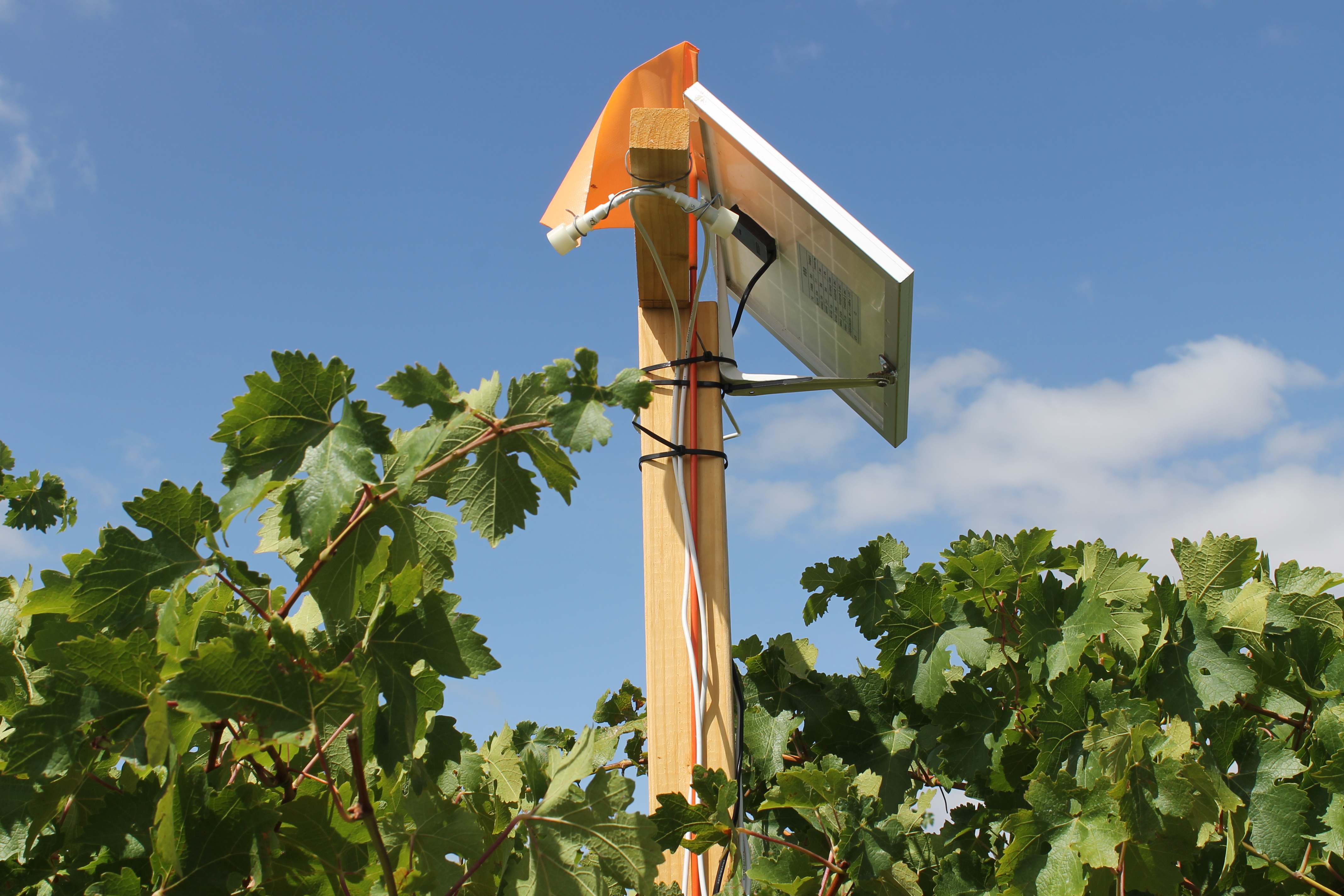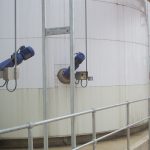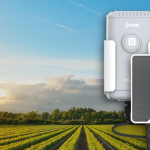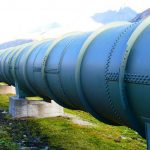Using thermographic towers to measure vine stress
Monitoring vine water stress and irrigation application can be a laborious manual task and is often hard to measure accurately. But not for long. After extensive trials on irrigation measurement in Coonawarra, a researcher has produced a prototype that could be the future for grapegrowers. Chloe Szentpeteri spoke to Dr Vinay Pagay, Dr Catherine Kidman and Chris Brodie, to discover what the technology can do.
Dr Vinay Pagay is a viticulture researcher at the University of Adelaide’s Waite Campus, Australia’s leading research education and commercialisation precinct for agricultural science.
Dr Pagay teaches several undergraduate and postgraduate classes in viticulture, vineyard technology and engineering, and it’s his invention that has already made a significant impact in Coonawarra vineyards.
So how do we keep our vines at optimum performance under adverse environmental conditions?
That’s the question Pagay had been asking himself, and his query lead to the production of a new prototype called a thermography tower.
The invention resulted from two trials conducted in the Coonawarra region, supported by the entire community and funded by Coonawarra Vignerons and Primary Industries and Regions South Australia (PIRSA).
The former was a project researching remote sensing aerial technology which began in 2015, and concluded in 2017 and was the foundation for stage two, the thermography towers.
Data from the remote sensing trial was correlated by flying planes with IR infra-red thermos-cameras and building relationships between temperature measurement of the vine and manual measurements from the soil of vine water status.
“From that we developed a small algorithm to convert that temperature into an index that corresponds very strongly to these measurements on the ground,” Pagay explained.
“It all came about from that remote sensing work and it was 2016–2017 that we started finding these relationships and then this idea of the towers was a natural follow on from that because we wanted continuous measurements in the field and wanted an automated process.”
Pagay said his background in electronics and electrical engineering abilities helped him to develop his new invention, the thermography towers.
“It was a nice transition from single time point measurements with a plane or a drone to continuous measurements of the same parameter, and we now have this algorithm which gives us very accurate assessments of vine water status and that’s what we’re hoping to use to drive and automate irrigation.”
The tower is equipped to translate the imagery data of any temperature in a given area, thus the thermal application.
“It’s taking a photograph with a special infra-red camera and these cameras can actually capture temperature right on a smart phone or on a specialised camera that can be flown on planes or drones or even on the ground like these towers are doing,” Pagay said.
“Essentially, the idea came from the remote sensing work where we started finding very good relationships between the temperature of the plants, being the vines, and water status, so essentially we are able to now convert a measurement of plant temperature to water status to the plant.
“These towers are doing exactly that.”
Consisting of microprocessors, the towers contain infra-red cameras that are mounted on top, which observe the vines down below.
Capturing the plant temperature continuously, the towers can be set to monitor intermittently at timeframes anywhere between seconds to hours.
“We’re constantly monitoring vine water status but translating that temperature into an algorithm — into a number that the growers in the industry understand as being water status,” Pagay explained.
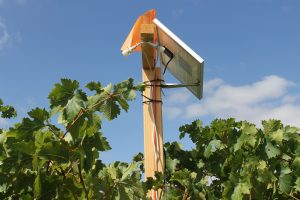
A thermography tower monitors the vines from above
Pagay said the thermography towers will be a useful tool for irrigation scheduling decisions for future use industry-wide.
By using these towers, the questions of when to irrigate, and certainly how, will be made much simpler due to its autonomous capabilities.
“This will be a nice tool because it’s something that we don’t have to send people out to measure vine water status temperature manually, which is labour intensive and time consuming,” Pagay added.
“We can then control irrigation systems in the future automatically which will allow us to dial water stress on the plant to get a certain quality or yield, and then off it goes!”
Despite the advanced technology, the one downfall is that the maximum land area the towers can measure is very little, unlike flying a plane or extrapolating data from a satellite.
The towers have four cameras, two per vine to capture both sides of the canopy, which presents an average single point measurement, which is an advantage.
Although the data isn’t representative of the entire vineyard, combined with other technologies, it is fairly accurate, and also inexpensive, which means they’re more adaptable for growers in future.
“They don’t cost much so you can put a fair number of them out into the vineyard. That’s the benefit compared to existing soil moisture sensors or other types of devices for water status,” Pagay added.
“We’re going to commercialise these towers and we’re in the process of that with a company called Athena Irrigation Technologies.
“We’ve now got a collaboration with Fleet Space Technologies, which is a local space company and they are providing us free satellite access to these towers so we can now transmit the data directly through their nanosatellites from remote locations.
“So if you’re in the outback where there’s no wireless, no 3G or 4G, you can use satellite transmission to get the data across,” he said.
Fleet Space Technologies is testing this wireless access which will result in multiple modes of communication.
Data will be accessible for download manually, through a smart phone, through the cloud or via satellite connectivity.
“No matter where you are in the world you can put these towers in and still get access to the data through these satellites,” Pagay exclaimed.
“We’ve got a lot of traction, and we’re very encouraged to push this technology and optimise irrigation.
“It’s very simple technology which keeps the price down, because the growers don’t have a lot of spare cash to throw around at new things. There’s already a lot of investment in the vineyard,” he added.
The team at Waite Campus and from Fleet Space Technologies is now in the process of rebuilding the hardware to a more robust model.
“We’ve obviously had some challenges, being in the vineyard is not easy for a device that comes fresh out of a lab,” Pagay laughed.
In addition to a sturdier structure, other aspects of communication will be added for the app and around a year from now, the thermography towers are expected to hit the market as a sellable, tested industry product.
After the models are released, Pagay is hopeful the towers will be a solid foundation for growers to use as a plant-based sensing approach.
Although a very common form of measurement, soil monitoring can be variable depending on different soil types, of which Coonawarra is a great example.
The terra-rossa type terroir lends itself to about three other soil types which have different responses to the vines.
Pagay said a single level of irrigation application to a block which has two soil types will not receive the same vine response, and so his lab is moving away from soil monitoring as an informed way to irrigate, and focusing on plant sensing of water.
“Ultimately we are interested in the plant and the crop, so why are we monitoring the soil?” he said.
“If we can interrogate the plant and get its water status, that’s the holy grail of irrigation monitoring.”
When asked what his advice was for growers, Pagay said to do the research and understand the subtleties of water use in individual cultivars of varieties in the vineyards, and how these respond to different amounts of water application.
“That’s something that I think is somewhat underappreciated and somewhat neglected. Different varieties can’t be treated the same way.”
“The reality is that one level of irrigation in the vineyard is not optimum and we are trying to optimise that irrigation by using these towers,” he said.
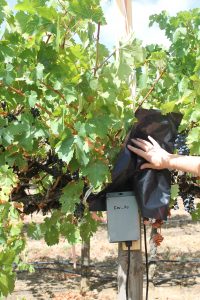
The mainframe of a thermography tower
A grower’s perspective
Although the invention of the thermography towers is very much Pagay’s ‘baby’, their establishment wouldn’t have been possible without the work of Wynns Coonawarra Estate’s regional viticulturist, Dr Catherine Kidman, or Katnook Estate’s general manager of vineyards, Chris Brodie.
Dr Kidman has a Bachelor of Science, specialising in Viticulture and Enology as well as a PhD in Philosophy, Viticulture and Enology, and has extensive experience in the field.
Chris Brodie hails from New Zealand, with a strong background in horticulture, and over 20 years of experience in viticulture and management in the wine industry.
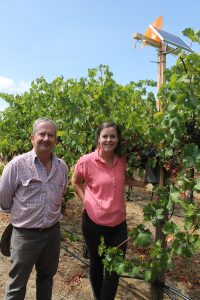
Chris Brodie and Catherine Kidman
The duo have worked closely with Pagay to trail the thermography towers in the vineyard and both Kidman and Brodie agree that it’s a substantial development and a simpler, more accurate method of measuring vine water stress and scheduling irrigation applications.
“If we look at the map that we get from these thermographic images, we can start to understand how stressed those vines are getting on a daily basis and how long it takes them to recover,” Kidman said.
“The technology we’re using that Dr Pagay has come up with, these are logging 24/7 so we’re getting a really good footprint of what that vine is doing diurnally on a daily and nightly basis.”
“That feeds into our irrigation decisions because we can actually see the impact of that irrigation application on how the vines are responding to it and how they’re recovering or not,” she added.
By integrating soil measurements with the towers’ thermal imagery, Kidman and Brodie have been able to identify how dry the soil is getting and what the vine’s response is to inform irrigation applications.
They then look at the ground measurements of plant water status and use several techniques to determine how tightly the vine is holding water under pressure.
One of them is perometry, looking at stomatal aperture, the photosynthetic rate and the stem water potential.
“But they’re research tools, so we use them but they are a bit like our soil moisture tools, you can only take a number of measurements and they’re usually at specific times of the day, and you have to extrapolate that data out,” Kidman explained.
“So in a commercial sense when you’ve got vineyards of size, that’s not viable because you can’t have somebody taking as many measures of statistical significance to have confidence of that number.”
And that’s why the community of Coonawarra wanted a tool that could effectively be placed throughout the whole region, which thermography towers can be.
Kidman echoed Pagay’s thoughts on how successful the remote aerial sensing trial was and how it informed the research of the thermography towers.
Although the aerial sensing via plane is similar to the towers, the ease of access via the ground combined with continuous data logging and the low cost made more sense.
In particular, the towers have helped monitor different grape varieties and prevent them from too much vine water stress.
“Our two main varieties in Coonawarra are Cabernet and Shiraz and they are two very different personalities. This is all still being proven and disproven but essentially they do behave quite differently and it’s kind of easy to tell when Shiraz is getting stressed,” she said.
Visually, it is easier to identify Shiraz under vine water stress as there tends to be basal leaf yellowing and what Kidman referred to as ‘sad and unhappy’ vines.
This is known as isohydric and anisohydric grapevines.
“To put it in layman’s terms, Shiraz is an optimistic variety. It will show its personality and get upset and require that replenishment of water, but it’ll also think, ‘Chris is going to irrigate me tonight so I’ll lose all my water but it’ll get replaced’,” Kidman mused.
“Cabernet is a different creature altogether, it’s still being proven but it’s more of a pessimistic personality type in that it’s really hard to see when it’s at that stress point.”
“It doesn’t have the visual characteristic and tends to hold a bit of a grudge. If you do put a bit of stress on it, it will show in its fruit,” she explained.
Vine water stress can then result in changes to tannin structure, the flavour profile and different characteristics.
In this sense, the towers have played a large part in accurate irrigation application and assessing the vines accurately, before the plant gets too stressed.
“So we can turn the irrigation on or off depending on the stress triggers of the vines and what we’re wanting to do is impose different stresses so we can look at the different response of the vineyard to that,” Kidman explained.
“We’ve got little taps and water metres that we can see how much water we’re putting on.”
Alternatively, Brodie said the towers also help to identify how much stress to put on the vines.
“We do want a bit of stress, we want to stop them from growing and focus their energy towards producing all these wonderful flavours that Coonawarra does and this will help us do that.
“In time we’ll be able to say, at this level coming from the tower, that irrigation will switch off and that will take a lot of error out of this and help us determine what decisions to make with the weather.
With climate change, this will help us preserve our water supply because we don’t have much here. We need to be careful or we’ll use it up so this will be a key tool in helping us do that,” he said.
Brodie and Kidman said the benefits of this new technology are widespread, and as new models receive the relevant upgrades it will change the way Coonawarra irrigates.
“I’m hoping this will change our mindset of how we think about the grapevine and how it’s irrigating and what it’s losing based on the environment so it’s just changing our conversations on how we think about irrigation so it’s really empowering because we’re not having a closed vision on it, we’re trying to open it up and see what we can learn from it,” Kidman said.
“We’ve got three towers in this [Wynns] vineyard so what we’d do at this stage is combine a few technologies, and use those plans to give an aerial map which is really important as a special investigative tool.
“And then what we’d do is hone in on the variability within vineyards and put these towers in those spots.
“Depending on the variability of the vineyard you might have two or three, or six or seven so with the low cost it wouldn’t be much of an impact on finances,” she concluded.
As research continues in the vineyard and the prototypes are being assessed, the new models are in the process of upgrading.
In a year’s time, thermography towers may have just hit the market, and the hope of Kidman and Brodie is that these ‘little babies’ will be available for less than $200, Australia wide.
